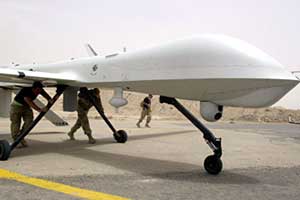|
TALLIL AIR BASE, Iraq, June 30, 2003 (AFPN) -- It
hunts alone, flying quietly for more than 20 hours at a
time, carefully scouring the Earth for the most minute
evidence of ground activity and discretely relaying
intelligence information to analysts half a world
away.
But on a moment's notice, the Predator unmanned
aerial vehicle can transform itself from a forward
aerial observer to an opportunist attack-craft capable
of delivering an armor-busting missile with pin-point
accuracy.
The Predator is a complete system, not just an
airframe by itself. A fully operational system consists
of four aircraft with sensors, a ground-control station,
a satellite link and about 55 people to support
continuous 24-hour operations. To the airmen here who
fly them, the system is more than just an expensive
video game. |
 |
|
Airmen
from the 64th Expeditionary Reconnaissance
Squadron position a Predator unmanned aerial
vehicle at Tallil Air Base, Iraq. The Predator is
a complete system, not just an individual
airframe. A fully operational system consists of
four Predator units, a ground-control station, a
satellite link and about 55 people to support
continuous 24-hour operations. U.S. Air Force
photo by Master Sgt. Deb Smith
Inside the Predator’s brain, there is room for
a crew of two.
Full
Story by Air Force 2nd Lt. Gerardo Gonzalez,
407th Air Expeditionary Group
Service | |